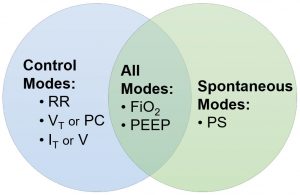Ventilator Settings Table
The main ventilator settings that are important to understand are:
Ventilator setting |
Description |
Unit of measurement |
Used in which mode(s)? |
|---|---|---|---|
| Respiratory Rate (RR) | The number of breaths per minute. It can refer to set RR—how many times a minute the ventilator will deliver a mechanical breath; RR is set by the health care professional, and is consistent unless changed. It can also refer to spontaneous RR, which is how many times a minute the patient is breathing—decided by their individual drive to breathe and their own brain trigger. | breaths per minute (bpm) | A baseline is set in control modes, but patients can breathe above the set rate. Monitored in both mode types to see what the patient is doing. |
| Tidal Volume (VT) | The volume of air filling the lungs during a breath. | mLs (of air) | Can be set on the ventilator in Control modes (specifically in Volume Control). Monitored in spontaneous modes to see what the patient is able to draw from the ventilator. |
| Pressure Control (PC) or Inspiratory Pressure (Pinsp) | The amount of pressure at which the ventilator will deliver every single breath to inflate the lungs. | cmH20 | Set in Control modes (specifically in Pressure Control). |
| Pressure Support (PS) | The amount of “extra help” the ventilator will give whenever the patient spontaneously breathes. It is meant to help unload some of the work of breathing that the patient may have. | cmH20 | Set for spontaneous modes only. |
| Inspiratory Time (IT) | The amount of time air/pressure is given by the ventilator to fill the lungs for a mandatory breath. | seconds (s) | Set in Control modes only. |
| Flow (V̇) | The maximum speed that the air can travel coming out of the ventilator when giving a breath. | liters per minute (lpm) | Set in Control modes only. |
| Positive End Expiratory Pressure (PEEP) | Substitutes for FRC since intubating and attaching to a ventilator bypasses the normal pressures in the lungs and maintaining “physiologic PEEP.” PEEP is important for stopping the alveoli from collapsing and making it easier to inflate the lungs (see Chapter 1). | cmH20 | Always set whenever a person is attached to a ventilator in both control and spontaneous modes. It is necessary to try to maintain a normal physiologic process. |
| Fraction of inspired oxygen (FiO2) | The percentage of oxygen the patient requires to support their oxygen needs. Normal air is approximately 21% Oxygen, so a setting of 0.21 is the absolute lowest you will ever go. The maximum amount of oxygen that can be delivered is 100% (pure oxygen)—so 1.00 is the highest possible setting. | a decimal from 0.21 to 1.00 | Always set whenever a person is attached to a ventilator in both control and spontaneous modes. |
Not all of these settings are set every single time. Depending on the mode of ventilation, different settings will be used. The following Venn diagram summarizes when settings are used:

Media Attributions
- Ventilator Settings Organized by Mode © Melody Bishop

